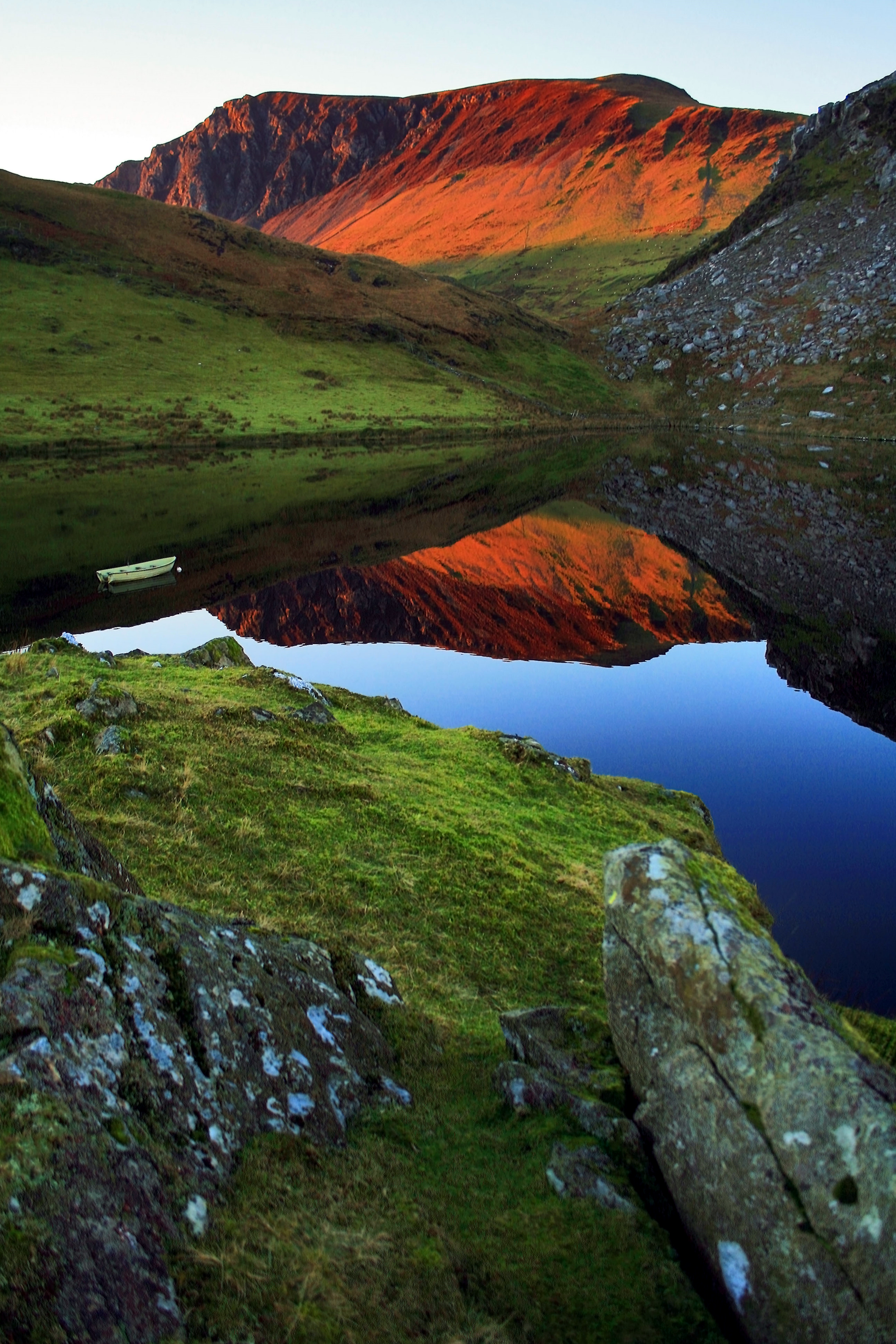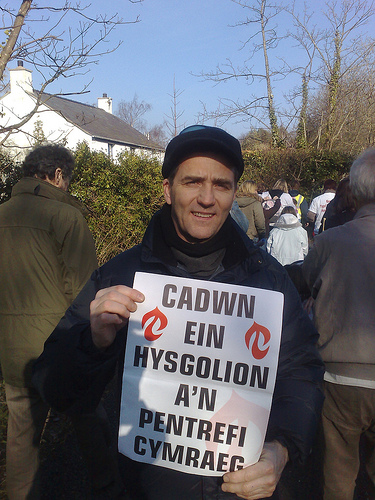|
Dyffryn Nantlle
The Nantlle Valley (, ) is an area in Gwynedd, North Wales, characterised by its numerous small settlements. The area is also historically important geologically, and featured in one of the most contentious disputes of the 19th century, between the ' Diluvialists' who believed in the Biblical flood, and the ‘Glacialists’, who supported the Glacial Theory, which was substantially established by studies of the drift sediments on Moel Tryfan. Between 85 and 90% of the population of the Nantlle Valley speak Welsh as their first language. Some of the communities came into being as a result of slate quarrying in the late eighteenth or early nineteenth centuries, and some have a history stretching back to antiquity. There are Iron Age forts at Caer Engan in Pen-y-groes and on the coast at Dinas Dinlle and evidence of Bronze Age settlement on the higher ground. The valley was important during the Middle Ages, with a ''clas'' or ecclesiastical college developed at Clynnog Fawr. ... [...More Info...] [...Related Items...] OR: [Wikipedia] [Google] [Baidu] |
Blodeuwedd
Blodeuwedd (; Welsh "Flower-Faced", a composite name from ''blodau'' "flowers" + ''gwedd'' "face"), is married to Lleu Llaw Gyffes in Welsh mythology. She was made from the flowers of broom, meadowsweet and oak by the magicians Math and Gwydion, and is a central figure in ''Math fab Mathonwy'', the last of the ''Four Branches of the Mabinogi''. Role in Welsh tradition The hero Lleu Llaw Gyffes has been placed under a '' tynged'' ("doom") by his mother, Arianrhod, that he may never have a human wife. To counteract this curse, the magicians Math and Gwydion: Some time later, while Lleu is away on business, Blodeuwedd has an affair with Gronw Pebr, the lord of Penllyn, and the two lovers conspire to murder Lleu. Blodeuwedd tricks Lleu into revealing how he may be killed, since he cannot be killed during the day or night, nor indoors or outdoors, neither riding nor walking, not clothed and not naked, nor by any weapon lawfully made. He reveals to her that he can only be kill ... [...More Info...] [...Related Items...] OR: [Wikipedia] [Google] [Baidu] |
Carmel, Gwynedd
Carmel is a small village near Y Fron in Gwynedd, north-west Wales. The village is built up mainly of Victorian homes, with a more modern area. The village contains a number of chapels, which are gradually closing down and some being converted into homes. The Victorian village school and post office have also been closed. The last of the village's shops closed in 2014 (Siop Doris). There are a number of other businesses including a driving school, coal merchant A coal merchant is the term used in the UK and other countries for a trader who sells coal and often delivers it to households. Coal merchants were once a major class of local business, but have declined in importance in many parts of the developed ... and a garage. Nearby villages are Penygroes and Groeslon. Notable residents have included Dafydd Glyn Jones, Sir Thomas Parry (1904-1985), Principal of University College of Wales, Aberystwyth, from 1958 to 1969 [...More Info...] [...Related Items...] OR: [Wikipedia] [Google] [Baidu] |
Aberdesach
Aberdesach is a small village in a primarily Welsh speaking area of Gwynedd. It is in the historic county of Caernarfonshire. The village is situated approximately 1.5 miles south of the neighbouring village of Pontllyfni and 6 miles south of the county town of Caernarfon Caernarfon (; ) is a List of place names with royal patronage in the United Kingdom, royal town, Community (Wales), community and port in Gwynedd, Wales. It has a population of 9,852 (with Caeathro). It lies along the A487 road, on the easter .... External links www.geograph.co.uk : photos of Aberdesach and surrounding area Villages in Gwynedd Clynnog {{Gwynedd-geo-stub ... [...More Info...] [...Related Items...] OR: [Wikipedia] [Google] [Baidu] |
Rave
A rave (from the verb: '' to rave'') is a dance party at a warehouse, club, or other public or private venue, typically featuring performances by DJs playing electronic dance music. The style is most associated with the early 1990s dance music scene when DJs played at illegal events in musical styles dominated by electronic dance music from a wide range of sub-genres, including drum and bass, dubstep, trap, break, happy hardcore, trance, techno, hardcore, house, and alternative dance. Occasionally live musicians have been known to perform at raves, in addition to other types of performance artists such as go-go dancers and fire dancers. The music is amplified with a large, powerful sound reinforcement system, typically with large subwoofers to produce a deep bass sound. The music is often accompanied by laser light shows, projected coloured images, visual effects and fog machines. Fuelled by the emerging dance scene, and spearheaded by acid house music and undergro ... [...More Info...] [...Related Items...] OR: [Wikipedia] [Google] [Baidu] |
Glynllifon
Glynllifon is an old estate which belonged to the Baron Newborough, Barons Newborough, near the village of Llandwrog on the main A499 road between Pwllheli and Caernarfon in Gwynedd, Wales. The original mansion was until recently a privately owned hotel. Parc Glynllifon The greater part of the original park, Parc Glynllifon, now includes Coleg Glynllifon agricultural college, craft workshops and many educational facilities. There are also a cafe and maze at the entrance, and exhibits such as an 1854 De Winton horizontal stationary steam engine and Cornish boiler, which were restored by Fred Dibnah, can be seen. Many fairs are held in Glynllifon Park car park, especially steam and craft fairs. The park is open to the public and includes gardens of historical and scientific importance; they have been designated National Register of Historic Parks and Gardens, Historical Garden (Grade I) status as well as a Site of Special Scientific Interest by Cadw and the Countryside Council fo ... [...More Info...] [...Related Items...] OR: [Wikipedia] [Google] [Baidu] |
Bryn Fôn
Bryn Fôn (born 27 August 1954) is a Welsh actor and singer-songwriter. He also became the first artist to play live on BBC Radio Cymru in 1977. Biography Bryn Fôn was born in Llanllyfni, Caernarfonshire. He attended Ysgol Gynradd Llanllyfni and Ysgol Dyffryn Nantlle before going on to study physical exercise and environmental studies at college. He began his career in entertainment by taking part in the opera Dic Penderyn in 1977. He formed the musical group Crysbas after leaving college, and Sobin a'r Smaeliaid in 1988. He was voted the ''hunk of the month'' in '' She'' magazine during the 1980s. He began releasing albums with his band under his own name in 1994. He and his band later performed under the name Bryn Fôn a'r Band, releasing music under their own label . He won the song contest Cân i Gymru in 1997, with ''Un Funud Fach''. In his later career, Fôn has concentrated on appearing on stage and also adapted the play '' Blackbird'' for a production by Theatr B ... [...More Info...] [...Related Items...] OR: [Wikipedia] [Google] [Baidu] |
Bryn Terfel
Bryn Terfel Jones (; born 9 November 1965), is a Welsh bass-baritone opera and concert singer. Terfel was initially primarily associated with the roles of Mozart, particularly '' Figaro'', '' Leporello'' and ''Don Giovanni,'' but he has subsequently shifted his attention to heavier roles, especially those by Puccini and Wagner. Biography Terfel was born in Pant Glas, Caernarfonshire, Wales, the son of a farmer. His first language is Welsh. He chose Bryn Terfel as his professional name to avoid confusion with another Welsh baritone, Delme Bryn-Jones. He had an interest in and talent for music from a young age. A family friend taught him how to sing, starting with traditional Welsh songs. After winning numerous competitions for his singing, Terfel moved to London in 1984 and entered the Guildhall School of Music and Drama, where he studied under Rudolf Piernay. In 1988, he entered and won the Morriston Orpheus Choir Supporters' Association Young Welsh Singer of the Year Com ... [...More Info...] [...Related Items...] OR: [Wikipedia] [Google] [Baidu] |
Jerry Hunter
T. Gerald Hunter FLSW, more commonly known as Jerry Hunter, is an American graduate of the University of Cincinnati (BA), Aberystwyth (MPhil) and Harvard University (PhD). Originally from Cincinnati, he now lives in Wales and has held academic posts at Cardiff and more recently Bangor University, where he is currently (2015) a professor in the School of Welsh and deputy vice chancellor of the university He was a founding member of the pressure group Cymuned and is former editor of the Academi's literary periodical ''Taliesin''. His first monograph, ''Soffestri’r Saeson'' (University of Wales Press, 2000), a study of the use of prophecy as political propaganda in the Tudor age, was shortlisted for the Wales Book of the Year award in 2001. ''Llwch Cenhedloedd'', (Gwasg Carreg Gwalch, 2003), which writes the history of the American Civil War based on Welsh-language evidence (mainly letters and other material written and published in Welsh on both sides of the Atlantic), won the W ... [...More Info...] [...Related Items...] OR: [Wikipedia] [Google] [Baidu] |
John Selwyn Lloyd
John Selwyn Lloyd (1931 – 22 March 2023), known professionally as J. Selwyn Lloyd, was a Welsh-language author of novels for children and young adults. Biography Lloyd was born in Talysarn in the Nantlle Valley, a heavily Welsh-speaking area of North Wales. Lloyd lived in Corwen. He died at a residential home in Caernarfon on 22 March 2023. Awards * Tir na n-Og Award in 1977 and 1983 * Tlws y Ddrama at the National Eisteddfod of Wales in 1979 for ''Ychydig wedi naw''. * Mary Vaughan Jones Award in 2000 BBC Cymru 13.10.2000 Bibliography * ''Owi Tŷ Pella'' (Hughes, 1960) * ''Llam y Lleidr'' (Hughes, 1967) * ''Creithiau'r gorffennol'' (Gwasg Gomer, 1972) * ''Dychweliad y swastika'' (D. Brown a'i Feibion, 1973) * ''Breuddw ...[...More Info...] [...Related Items...] OR: [Wikipedia] [Google] [Baidu] |
Kate Roberts (author)
Kate Roberts (13 February 1891 – 14 April 1985) was one of the foremost Welsh-language authors of the 20th century. Styled ('The Queen of our Literature'), she is known mainly for her short stories, but also wrote novels. Roberts was a prominent Welsh nationalist. In 1963, she was nominated for the Nobel Prize in Literature by Welsh scholar Idris Foster. Life Kate Roberts was born in the village of , on the slopes of , Caernarfonshire (Gwynedd today). She was the oldest child of Owen Roberts, a quarryman in the local slate industry, and Catrin Roberts. She had two half-sisters and two half-brothers (John Evan, Mary, Jane and Owen) from earlier marriages of her parents, and three younger brothers (Richard, Evan and David). She was born in the family cottage, . Later the life in the cottage and village made an all-important backdrop to her early literary work. Her autobiographical volume is a memorable portrayal of the district in that period. She attended the council sc ... [...More Info...] [...Related Items...] OR: [Wikipedia] [Google] [Baidu] |


